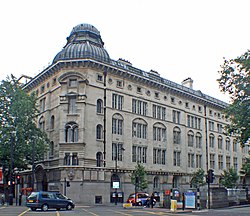History
1822 – Henry Hetherington printing press
In 1822, the Chartist Henry Hetherington registered a printing press at 13 Kingsgate Street (a smaller street parallel to King street, but demolished during the 1903-05 Kingsway development). This was an eight-roomed house, including shop and printing premises—at an annual rent of £55. [30] His first published book was in January 1823, and was named Mudie's journal, the Political Economist and Universal Philanthropist. [31]
1899 – Sir John Barbirolli was born
Sir John Barbirolli, the conductor and cellist, was born in Southampton Row on 2 December 1899. A commemorative blue plaque was placed on the wall of the Bloomsbury Park Hotel in May 1993 to mark his birthplace. [37]
1953 – beginning of the Sue Ryder Care charity
The Sue Ryder Care charity, established in 1953, is registered at 114–118 Southampton Row.
1953 - bookshop opening
Also in 1953, John Cass opened a bookshop on Southampton Row, where he began publishing books and journals which were acquired by Taylor & Francis in 2003. [42]
1966 – Indica Bookshop and Indica Gallery separation
In 1966, the Indica Bookshop was separated from the Indica Gallery, a counterculture art gallery supported by Paul McCartney, and moved to 102 Southampton Row in the summer of that year.












